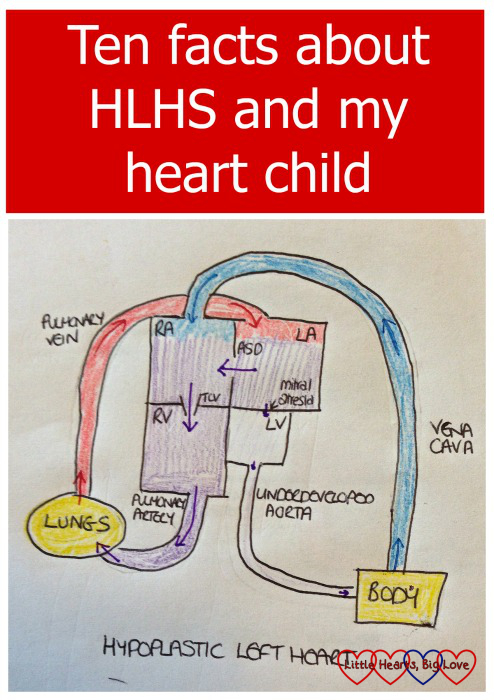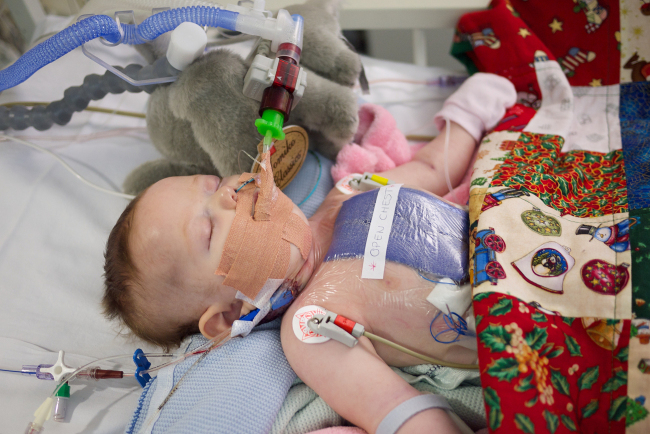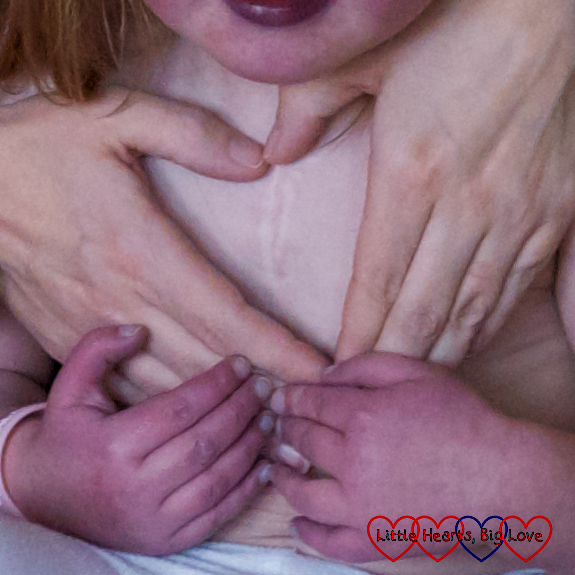My daughter Jessica has a complex congenital heart defect called hypoplastic left heart syndrome (HLHS). Children born with HLHS effectively have only half a working heart. Here are ten facts about HLHS and my heart child:
1) HLHS occurs in approximately 1 in every 5000 babies.
2) It is a condition where the left side of the heart is significantly underdeveloped. The left hand side of the heart receives oxygenated blood from the lungs and pumps that blood around the rest of the body. If this side of the heart is not developed properly, the oxygenated blood cannot travel around the body. An HLHS baby is able to survive in the womb because the fetal circulation has a few differences from the post-birth circulation, which allow the blood to travel around the body. Once the baby is born though, the circulation changes. Surgery is needed in order for the child to survive. You can read more about the differences between the circulation in a normal heart compared with HLHS here.
3) When a child is born with HLHS, parents are usually offered two choices. One is to to pursue the surgical route; the alternative is to opt for comfort care (keeping the baby comfortable and allowing them to pass away peacefully).
4) Children with HLHS will need at least three open-heart surgeries in order to survive into adulthood. The first of these is the Norwood procedure. This is usually performed shortly after birth. The second, the Glenn, is done at a few months old, and the final surgery, the Fontan, at around 3-6 years old.
5) Dr William Norwood performed the first successful Norwood procedure in 1981. Before this, all babies born with HLHS died shortly after birth. The oldest HLHS survivors therefore are in their thirties. Approximately 70% of children born with HLHS will survive into adulthood. Long-term survival beyond this is unknown.
6) Jessica’s heart defect was complicated by a restrictive atrial septum. This made it harder for the blood to travel between the top two chambers of her heart in the womb. Because of this her prognosis was particularly poor. She had her first heart surgery whilst in the womb. This surgery enlarged the hole between the top two chambers of her heart to allow blood to flow between them. As far as we know, she was the first baby in the UK to have that particular surgery done in-utero. She may be the only baby to have had it. I’ve yet to encounter another family who’ve had a similar procedure in the UK.
7) Jessica’s anatomy meant she was high-risk for the Norwood procedure. Because of the increased risk, Jessica had a two-part surgery, known as the hybrid procedure, carried out instead. She was just eight hours old when she had her first open-heart surgery as part of this procedure. The second part too place a week later. The hybrid procedure helped buy time for her circulation to grow and her blood pressure to reduce before having the Norwood procedure at three months old.
8) HLHS is a “cyanotic” heart condition. This means that the blood going around the body has a much lower percentage of oxygen than in a normal circulation. Normal oxygen saturation levels are around 96-99%. Jessica’s are usually around 78-82%. Because of her low oxygen saturation levels, Jessica’s skin often has a bluish tinge. This is particularly noticeable on her hands, feet and lips. Having low blood oxygen levels means that Jessica has less energy than other children her age and gets cold very easily. She can go very blue when she is cold. Winter can be a particularly tricky time of year for her.
9) Jessica has to take captopril and aspirin daily to help support her heart function. At the moment she has medicine four times a day. This is quite easy to remember as part of our daily routine. However, there have been times when writing a medicine schedule and putting it on the fridge was the only way to keep track of all the various medicines Jessica has needed along with the doses and when to give them.
10) HLHS is not something that can be fixed. The surgeries basically “replumb” the heart, adapting the circulation so that the right side of the heart does all the work. A child with HLHS will still only have half a working heart though. The change in circulation comes with an increased risk of blood clots. Jessica will need to be on anticoagulant medication for the rest of her life. She will also need regular check-ups to monitor her heart function.





Oh wow, they have made a huge improvement here for babies born with HLHS! It’s wonderful that a choice exists now & surgeries are an option. Poor Jessica, it must be so hard on her to have all of these surgeries & on your whole family too. I always fill up reading your heart posts. I can’t imagine the worry you have. It’s wonderful that she is doing well & please God she continues to do well. You really are doing an amazing job raising awareness this month! #TwinklyTuesday x
Thank you Becky – it’s amazing how much progress has been made in the last thirty years or so and how even more recent procedures have made a difference. It is wonderful to see how well she is doing now and having been through such a journey to get to this point really does make me focus on the here and now because I know just how lucky I am to have that.
Wow I’m so glad medicine has moved on so much for Jess and you. I bet the surgery in the womb was so scary and I can’t imagine how worrying it must have been for you both. I’m so glad she does so well and looks so happy, even if she has a large list of medications to take! You do so well coping and just enjoying life! xx #twinklytuesday
Thanks Sarah – it is amazing the advances that have been made in surgery to help children with the kind of heart defect that Jessica has. The surgery in the womb was very scary but knowing that it was Jessica’s only chance made it easier in a way. It is wonderful to see how well Jessica is doing at the moment, we are so lucky that she is here and living life to the full x
Jessica has really been through it. The poor love!
You are amazing too….Raising awareness and being a brilliant mother x
Thank you Kim x
Thank you for the explanation Louise, I didn’t really appreciate quite what you have gone through till now or what a miracle Jessica is, she really is a fighter and so worth fighting for xx #TwinklyTuesday
Thank you Fiona – it is amazing to realise just how far Jessica has come, she really is my little miracle.
Hi Louise, I think that raising awareness like you do about heart children and their families is amazing and such the right thing to do. If people like you don’t share what you know and what you go through, then other people (like me) have no way of knowing.
It must be terrible not knowing what the future holds for Jessica, but you seem to cope admirably. With technology and medical expertise improving all the time, I hope that it means that children like Jessica grow up to lead long and happy lives.
Thank you for educating us.
xx
Thank you Debbie – I think that fear of the future is one of the hardest things but it does teach you to live in the moment and enjoy it.
Wow! This made me tear up because I can’t how you are dealing with this. It is so amazing that you are raising awareness about this issue. I’m also so glad that your little girl is doing well and I hope that the medical field continues to make improvements so that she can live a long and happy life. The medical field has come so far and I think that it will continue to surpass even what they are doing now. Thanks so much for sharing your story with us! I found your on #bloggerclubuk Facebook group.
Thank you Michelle – it is amazing to see how well she is doing now and amazing what modern medicine can do x
Poor Jessica, I can’t imagine how difficult any of this has been on her and your entire family. You always do such a good job of raising awareness. Thanks for linking up to #TheList x
Thanks Aby – it’s certainly been quite a rollercoaster. Lovely to link up again, thanks for hosting.
I’d never heard of HLHS until reading your post. It’s wonderful to hear improvements are being made medically compared to over 30 years ago. It must be awful for parents knowing their child has major heart surgery ahead of them but at least it brings hope that they will reach adulthood and beyond. Xx
It’s something that most people won’t have heard of unless they know someone with it. It’s amazing how much can be done now compared to 30 years ago and knowing that medical advances still continue to be made helps to give me hope x
I am 39 and I have hlhs. My left Ventricle didn’t develop at all. I was born on 1978. I had two minor surgery before O was one. I was always blue. I made it to 8 years old and then I had a Blalock shunt, I had another surgery when O turned 16. When I was 18 I finally had a Fontan. That was my last open heart surgery. I have to take medicine on a strict schedule. I have had a stroke and a few mini strokes but I live a pretty normal life. I work part-time, drive, dance a little, live on my own ( with a cute guy) and according to my cardiologist I am doing very well. He says I just may out live everyone. Haha. I just wanted to l3t you know there are survivers. ♥️ Niki
That’s amazing Niki, thank you so much for sharing your story and helping give me hope for my daughter’s future. It sounds like you are doing very well and long may that continue x
My little brother Eli has HLHS. He is getting his last surgery in March 2022. I hope he makes it.(:/):
I hope all goes well with Eli’s surgery. Sending positive thoughts your way.